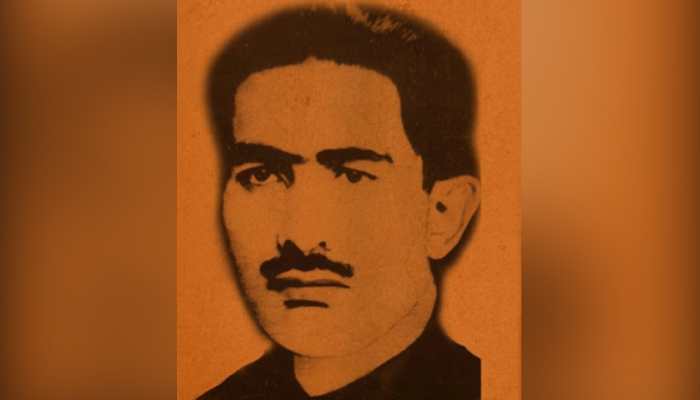

Maqbool Sherwani
The 16-day invasion of the Pakistani Army-backed tribal raiders failed in Kashmir due to a strong military response from the Indian Army which landed at the Srinagar Airport immediately after Maharaja Hari Singh signed the Instrument of Accession with India on 26 October 1947. However, the role played by some Kashmiri volunteers, like the Baramulla-based Maqbool Sherwani, was historic.
Sherwani is said to have misled the raiders and it was because of him that the invaders lost four crucial days. By the time they reached Budgam and were about to capture the Srinagar Airport, the Indian Army unit led by Major Somnath Sharma landed and repulsed their advance.
After realising that they were being misguided, the raiders captured and hanged him in the central square of Baramulla. The courage with which he sought to impede the advance of the tribals and the intensity of his loyalty and commitment towards his motherland made him popular as the ‘Lion of Baramulla’. Every year, in his memory, at Maqbool Sherwani Auditorium and Mohammad Maqbool Sherwani Memorial in Baramulla, tributes are paid to him on his anniversary.
People in Baramulla believe that Sherwani was hanged and shot dead and his body was fixed to a poplar tree with nails. However, the available historical evidences don’t support these graphics of the brutality.
Born in a Baramulla family that owned a small soap factory, Sherwani had joined Sheikh Mohammad Abdullah’s National Conference at a young age in 1939 when the organisation’s name was changed from Muslim Conference. He had a strong belief in the valley’s plural ethos, co-existence and communal harmony as Sheikh’s most popular slogan was “Sher-e-Kashmir Ka Kya Irshad, Hindu Muslim Zindabad”.
Sherwani used to recite the poems of the socialist revolutionary poets like Faiz Ahmad Faiz, Majrooh Sultanpuri, Ali Sardar Jafri, Sahir Ludhianvi and the valley’s own Ghulam Ahmad Mehjoor, Abdul Ahad Azad and Dinanath Nadim. He was part of the NC volunteers who joined the resistance forces of the national militia and led several detachments of militiamen to different areas instilling confidence and unity among the terror-stricken Kashmiris. On way to Srinagar, he cautioned a fleeing group of the Sikhs of Sopore-Rafiabad belt against taking the national highway route. However, his advice was ignored and the marauders reportedly massacred around 300 members of the minority community at Chhoora-Bulgam.
The Balidan Stambh monument by Jammu and Kashmir Light Infantry also bears the name of Maqbool Sherwani. Writer Mulk Raj Anand wrote an account of Sherwani’s story in his novel “Death of a Hero” which was later adapted into a television show, ‘Maqbool Ki Vaapsi’. Dooradrshan Kendra Srinagar telecast it in 2011.
Sheikh Abdullah, who took over as Jammu and Kashmir’s first Prime Minister in 1948, got Srinagar’s iconic civil line street Residency Road named as Maqbool Sherwani Road. A municipal hall in Baramulla still exists in Sherwani’s name. Besides, there is Maqbool Sherwani Ward at Sher-e-Kashmir Institute of Medical Sciences (SKIMS) Soura, in Srinagar.
According to the distinguished political and cultural historian Mohammad Yousuf Taing (87), the state government’s Department of Information had also made a documentary film on the tribal raid and highlighted Sherwani’s role in failing the invasion
“The Field Publicity Unit of the Information Department screened that film at some theatres in Srinagar as also on celluloid in several villages,” Taing told India Narrative in October 2020.
How Kashmir’s intellectual fraternity has viewed the tribal invasion is best archived in a chapter of “Kuliyaat-e-Mehjoor”, the complete collection of Ghulam Ahmad Mehjoor’s poems in Kashmiri language. Mehjoor (1887-1952) is indisputably the most representative voice of Kashmir’s cultural and literary domain in the last over three centuries.
Years before Taing published “Kuliyaat-e-Mehjoor” in 1985, Balraj Sahni with director Prabhat Mukherjee made Shayar-e-Kashmir Mehjoor, a film on Mehjoor, in 1970-72. Sahni himself played Mehjoor. It was screened at theatres in J&K and outside. Until now the valley’s most popular poet, Mehjoor is held at par with Faiz Ahmad Faiz in Urdu and William Wordsworth in English literature.
In his poem Nalla-e-Sherwani, Mehjoor sums up Sherwani’s suffering during the night of November 6/7 when he was in captivity of the raiders in Baramulla. It rhymes Sherwani’s message to the people of Kashmir on the last night of his life. Mehjoor, through Sherwani, calls the raiders ‘cannibals’ and ‘scoundrels: “The cannibals have descended from the mountains. They have the blood of a multitude of innocents on their hands. They have made my country a veritable hell. It was a garden of flowers and they have laid it in waste. They trained their arrows on the nightingales”.
Interestingly, however, Sherwani has been forgotten in Kashmir’s cultural and historical landscape. Seventy-three years later, there is no signboard to show the direction of Sherwani Road which is continuously known by its British colonial name of ‘Residency Road’. The Sherwani Hall at Baramulla gutted in a mysterious fire around 1989. It was reconstructed and a commemorative plaque in Sherwani’s name was installed by the then Governor, Lt Gen S.K. Sinha (Retd).
And hold your breath! Even Kulliyat-e-Mehjoor is nowhere available in J&K’s bookstores, reading rooms and public libraries. Its first and the last edition appeared in 1985. The chapter on the tribal invasion has neither been a subject of critical appreciation at a literary assembly nor taught in undergraduate, graduation or post-graduation courses of any college or university after the outbreak of insurgency in 1989.
Minister for Electronics and Information Technology Ashwini Vaishnaw said on Friday that the government is…
Renowned human rights activist and political analyst Amjad Ayub Mirza has expressed a strong denunciation…
As was widely expected, the Indian economy grew by 6.5 per cent in real terms…
World No Tobacco Day, marked annually on 31 May, addresses a major public health challenge--the…
Defence Minister Rajnath Singh, addressing officers and sailors onboard India's first indigenous aircraft carrier INS…
The leadership team from the Central Tibetan Administration (CTA) arrived in Tokyo to participate in…